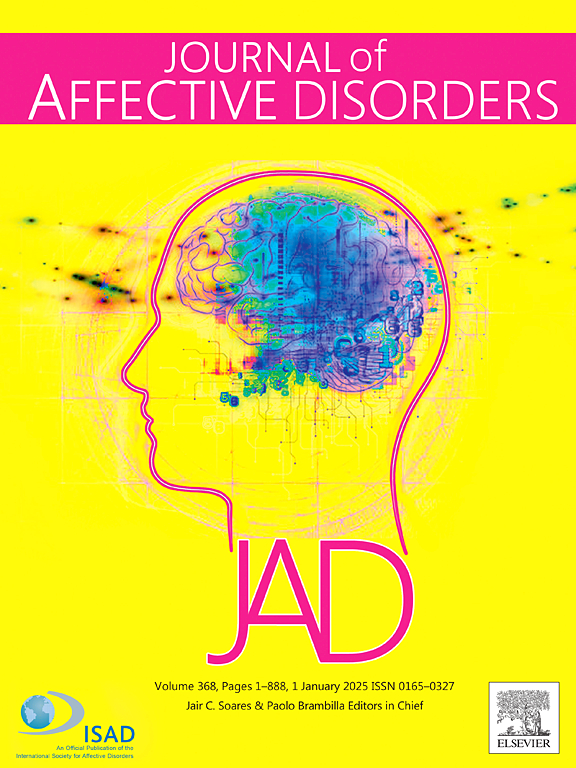内隐情绪调节缺陷的神经证据:一项比较PTSD伴与不伴酒精依赖的探索性研究。
IF 4.9
2区 医学
Q1 CLINICAL NEUROLOGY
引用次数: 0
摘要
背景:以往的研究已经确定精神共病,包括酒精依赖(AD),是治疗创伤后应激障碍(PTSD)的一个重要因素,但缺乏关于如何最好地治疗PTSD和AD共病的证据。情绪调节能力差可能是PTSD和AD合并症的重要潜在机制。方法:74名参与者(女性48名,男性26名)分为三组:健康对照组(HC组,N = 20)、PTSD无酒精依赖组(PTSD无AD组,N = 36)和PTSD合并酒精依赖组(PTSD合并AD组,N = 18)。他们在接受功能磁共振成像的同时完成了转移注意力情绪评估任务(SEAT)范式。结果:性别和亢奋症状可以预测AD的发病风险。在全脑fMRI数据中,与没有AD的PTSD相比,PTSD合并AD组在左侧枕中回(BA19_L)、右侧罗兰底盖(BA48_R)和右侧舌回(BA37_R)表现出明显的失活。此外,PTSD患者的AD与右侧舌回(BA37_R)有显著相关性。结论:这些发现揭示了PTSD伴AD和不伴AD患者之间差异的可能神经机制。这些区域在内隐情绪调节的背景下参与视觉通路、记忆加工和空间认知。观察到的这些区域的改变可能作为PTSD合并AD的神经诊断标记,并可能成为开发新疗法的潜在靶点。本文章由计算机程序翻译,如有差异,请以英文原文为准。
Neural evidence of implicit emotion regulation deficits: An explorative study of comparing PTSD with and without alcohol dependence
Background
Previous studies have identified psychiatric comorbidity, including alcohol dependence (AD), as a significant factor in treating posttraumatic stress disorder (PTSD), there is a lack of evidence on how best to treat comorbid PTSD and AD. Poor emotion regulation may be a key potential mechanism of PTSD and AD comorbidity.
Methods
Seventy-four participants (48 women and 26 men) include three groups: a healthy control group (HC group, N = 20), a PTSD without alcohol dependence group (PTSD without AD group, N = 36), and a PTSD with alcohol dependence group (PTSD with AD group, N = 18). They completed the Shifted Attention Emotion Evaluation Task (SEAT) paradigm while undergoing fMRI.
Results
Gender and hyperarousal symptoms were found to predict the risk of AD. In the whole-brain fMRI data, compared to PTSD without AD, the PTSD with AD group showed significant deactivations in the left middle Occipital Gyri (BA19_L), the right Rolandic Operculum (BA48_R), and the right Lingual Gyri (BA37_R). Furthermore, AD showed a significant correlation with the right Lingual Gyri (BA37_R) in individuals with PTSD.
Conclusion
These findings reveal possible neural mechanisms underlying the difference between PTSD patients with and without AD. These regions are involved in visual pathways, memory processing, and spatial cognition within the context of implicit emotion regulation. The observed alterations in these areas may serve as neural diagnostic markers for PTSD comorbid with AD and could be potential targets for developing novel treatments.
求助全文
通过发布文献求助,成功后即可免费获取论文全文。
去求助
来源期刊

Journal of affective disorders
医学-精神病学
CiteScore
10.90
自引率
6.10%
发文量
1319
审稿时长
9.3 weeks
期刊介绍:
The Journal of Affective Disorders publishes papers concerned with affective disorders in the widest sense: depression, mania, mood spectrum, emotions and personality, anxiety and stress. It is interdisciplinary and aims to bring together different approaches for a diverse readership. Top quality papers will be accepted dealing with any aspect of affective disorders, including neuroimaging, cognitive neurosciences, genetics, molecular biology, experimental and clinical neurosciences, pharmacology, neuroimmunoendocrinology, intervention and treatment trials.
 求助内容:
求助内容: 应助结果提醒方式:
应助结果提醒方式:


